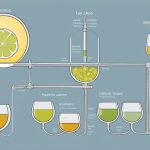Ale vs Beer: Exploring the Differences and Delving into the World of Craft Beverages
As a beer enthusiast, I have always been intrigued by the vast array of beverages available. From light and crisp lagers to rich and complex ales, the world of beer offers endless possibilities for exploration. But among all the options, one question often arises – what is the difference between ale and beer? Join me as we delve deep into this fascinating topic and unravel the nuances of these two beer styles.
What is Ale?
Ale is one of the oldest types of beer, with a history dating back thousands of years. It is characterized by its warm fermentation process, which takes place at higher temperatures. This method allows for a faster fermentation and contributes to the unique flavors and aromas associated with ales. Ales often have a fruity and robust character, with a wide range of styles to choose from.
One of my personal favorites, the India Pale Ale (IPA), falls under the ale category. IPAs are known for their hop-forward profiles, offering a delightful bitterness and citrusy aromas. Whether you prefer a classic English-style IPA or a bold and juicy American IPA, there is an ale out there to suit every taste preference.
And what about Beer?
Contrary to popular belief, all ales are beers, but not all beers are ales. Beer is a broader category that encompasses both ales and lagers. Unlike ales, beers are fermented using a cooler fermentation process, which results in a cleaner and crisper flavor profile. Lagers are often described as being more “refreshing” and “smooth” compared to ales.
One of the most well-known beer styles is the Pilsner, a type of lager originating from the Czech Republic. Crisp, golden, and highly carbonated, Pilsners are considered the epitome of a well-crafted beer. They offer a balance of malt sweetness and hop bitterness, making them incredibly drinkable and perfect for a summer day.
So, what sets Ale apart from Beer?
The primary difference between ale and beer lies in the fermentation process. Ales use a top-fermenting yeast that ferments at warmer temperatures, while beers, specifically lagers, use a bottom-fermenting yeast that ferments at cooler temperatures.
This distinction in fermentation temperature leads to variations in flavor, aroma, and appearance. Ales tend to have a more pronounced fruity and estery character, with a range of flavors such as caramel, toffee, and even tropical fruits. Beers, on the other hand, have a cleaner and crisper taste, with subtle malt and hop flavors.
Choosing Your Brew
When it comes to choosing between ale and beer, it ultimately boils down to personal preference. Some beer enthusiasts lean towards ales for their bold and robust flavors, while others prefer the lighter and more refreshing qualities of beers. The beauty of the craft beer industry is that there is something for everyone, regardless of your taste preferences.
If you’re new to the world of craft beer, I highly recommend exploring both ales and beers to discover your own palate. Visit local breweries and taprooms, engage with knowledgeable staff, and don’t be afraid to step out of your comfort zone. You never know when you might stumble upon your new favorite brew.
In Conclusion
The difference between ale and beer is rooted in the fermentation process, with ales being warm-fermented and beers being cool-fermented. Ales offer a wide range of flavors and aromas, while beers are known for their clean and crisp profiles. Whichever style you choose, the world of craft beverages is waiting to be explored and savored. Cheers to the adventure that awaits!







